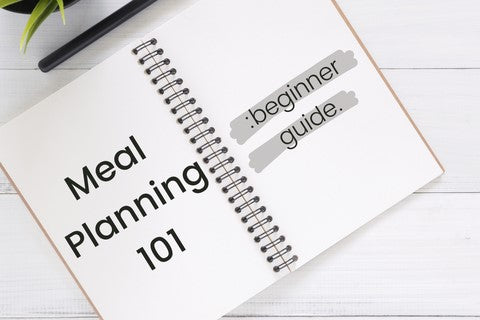
Meal Planning 101
June 24, 2021
Danquell Bradford

Meal planning can be a huge time saver in our ever growing busy lives. In this post we will go over simple steps on how to plan your dinners throughout the week. Meal planning takes approximately 30 min to do which can save you hours of time throughout the week. It’ll also save you money and help you eat a little healthier. It’s been shown to help people maintain a healthy weight, increase food variety, and diet sustainability (Ducrot et al., 2017).
My recommendation before starting is to have a note or document you can access on any of your devices where you can keep recipes you’ve liked. That way every time you try a new recipe and it's a keeper, you have somewhere to save it for next time. After a few weeks, you will have a personal cookbook you can rotate through each month. I would also suggest meal planning the day before you go grocery shopping so you know exactly what you need when you go.
Here are 5 simple steps on how to meal plan:
Step 1: Look at what food you need to use up in your kitchen. Look in the fridge, freezer, and pantry to see what needs to be used up before it goes bad. This is a great way to limit food waste and get all your use out of the money you already spent on previous groceries. Make a list of these foods for reference when you look up recipes.
Step 2: Now it is time to think about how you want to eat. This is where you think of any health conditions that may be affected by your diet like allergies, diabetes, heart problems, or obesity. What can you do this week to eat better and help your body function better? Something as simple as working in more vegetables or switching your bread/pasta to wheat.
Step 3: Let’s start searching for recipes! Bust out those old cookbooks sitting in your cupboards collecting dust and find some yummy dinner ideas. Searching online is also a great way to find recipes. Especially, if you are looking to make meals with more vegetables or trying to cut out a certain food like gluten or meat. You can search ideas like “dinner ideas with veggies”, “vegetarian dinners”, or “low carb dinners”. There are tons of recipes you can find, we also have some on our social media you can check out too! Then plan out what day of the week you will make each meal.
Step 4: As you find recipes and write them down for the week, start making your grocery list. That way you can kill two birds with one stone and be all set for your next grocery trip. You can also be a little creative and substitute ingredients in the recipes you find for what you already have in your pantry to bring down your grocery bill each week. I also recommend buying at least 1 item you can keep in your pantry or freezer to build up a stockpile of food in your house. This can be something you know you will use like canned fruit or bottled pizza sauce.
Step 5: Now you can go to the store and buy the ingredients you need for your week. Just stick to whatever you have on your list, if it isn't on the list don’t get it!
This is a simple guide to start meal planning your dinners. This does not mean that you will never eat out again but your chances of eating at home are higher because you have a plan. Cooking at home and cleaning it up every night can get exhausting so plan when you will eat out each week. You can make Friday your eating out day and something to look forward to through the week. If you have a partner, make it a date night! Whatever your circumstance, it is better to plan when you will eat out so you have a more realistic plan and don’t feel too restricted.
Source:
Ducrot, P., Méjean, C., Aroumougame, V., Ibanez, G., Allès, B., Kesse-Guyot, E., Hercberg, S., & Péneau, S. (2017, February 2). Meal planning is associated with food variety, diet quality and body weight status in a large sample of French adults. The international journal of behavioral nutrition and physical activity. https://www.ncbi.nlm.nih.gov/pmc/articles/PMC5288891/
